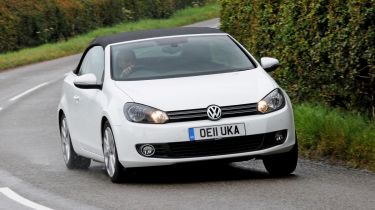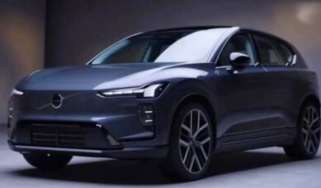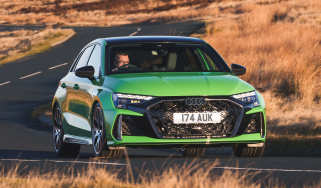Volkswagen Golf Cabriolet 1.6 TDI SE
A legend is reborn, and VW has matched comfort with pace
Few mainstream family cars can match VW’s Golf when it comes to pedigree – and the same applies to the drop-top.
The first roofless model was produced in 1979, and it quickly established itself as one of the best. After three generations and more than 34,000 UK sales, production halted in 2002. The arrival of the Eos coupe-cabrio in 2006 suggested the drop-top Golf was no more... until now.
Video: watch CarBuyer's video review of the Golf Cabriolet
[[{"type":"media","view_mode":"content_narrow","fid":"68804","attributes":{"alt":"","class":"media-image"}}]]
The new Cabriolet is based on the hugely successful Golf MkVI, and the similarities are clear at the front. But from the base of the windscreen backwards, it’s all change. The more steeply raked glass, fresh rear lights and redesigned bootlid are all intended to give the model a sportier look. A classy chrome strip runs around the waistline, separating the fabric hood from the surrounding bodywork.
The changes have been smoothly incorporated and, with the roof in place, the car’s neat proportions contrast with the bloated Peugeot’s, which is compromised by the complexities of its folding metal hard-top.
Dropping the Golf’s fully automated hood takes only 13 seconds, and reveals an attractive top-down profile. While the VW doesn’t have the prestige badge of the Audi, it does without fixed roll hoops behind the rear seats, which gives the newcomer a much cleaner appearance.
Used - available now

2023 Land Rover
Range Rover Evoque
39,115 milesAutomaticDiesel2.0L
Cash £25,197
2023 Mercedes
EQC
22,025 milesAutomaticElectric
Cash £27,197
2024 BMW
1 Series
18,601 milesAutomaticPetrol1.5L
Cash £20,988
2023 Citroen
C3 Aircross
15,028 milesManualPetrol1.2L
Cash £12,087Inside, it’s standard Golf fare. The dashboard design is straight from the hatchback, which is no bad thing. The cabin is a model of clarity and simplicity, marked out by superb build quality and top-rate materials. It’s the classiest choice in this line-up. Plus, the Cabrio shares its wheelbase with the hatch, so there’s a decent amount of legroom.
There’s space for only two people in the back, but rear passengers will be more comfortable in the Golf than in either of its rivals. The Peugeot is brighter inside when the roof is in place, though, thanks to its larger glass area. The Golf has split-folding rear seats as standard, and its 250-litre boot is unaffected when the top is folded. It’s virtually identical to the Audi in terms of volume, and shares the A3’s narrow opening. While the Peugeot’s 403-litre load area sounds big in comparison, the space shrinks to 226 litres when the top is down.
One thing you won’t be short of in the Golf is kit. In well specified SE trim, the VW comes with climate and cruise control, a wind deflector, rear parking sensors and Bluetooth all fitted as standard.
Add that lot to the Audi and you’ll put £1,395 on its price, which is more than enough to offset the A3’s cost advantage.
The Volkswagen doesn’t set the pace under the bonnet, though. Its 104bhp 1.6-litre diesel is shared with its VW Group rival, but the Peugeot produces 112bhp and comes with a six-speed, rather than the VW and Audi’s five-ratio gearbox. Against the clock, the Golf trailed the 308 CC by two-tenths of a second in the sprint from 0-60mph, with a time of 12.5 seconds, and was outgunned during the in-gear tests, too.
The pay-off comes at the tailpipe, where CO2 emissions of 117g/km are enough to place the VW in a lower tax bracket than the Peugeot. Straight-line performance is only part of the equation, and the Golf also compensates for its lack of outright pace in other areas. From its comfortable driving position to the perfectly weighted controls, the Cabriolet is every bit as polished as the hatch from behind the wheel.
As with its three and five-door stablemates, you get positive brakes, a smooth, light and precise gearshift, plus well weighted steering. The driving experience won’t rival a racy roadster’s for pure fun, but the Golf is incredibly capable.
Its front tyres provide real bite so there’s plenty of grip, and the suspension strikes a great balance between handling and comfort. Throw the Cabriolet into a corner, and it resists body roll effectively. Most impressive is the chassis’ apparent stiffness.
Extra strengthening beneath the skin compensates for the removal of the roof, and the resulting structure feels every bit as solid as the hatch. As a result, the suspension is unhindered by body flex, and it absorbs bumps and ruts effectively.
The VW is the only car to get a wind deflector as standard, but holding a conversation at speed with the top down is easy even when it’s not installed. Add class-leading economy of 45.2mpg to the mix, and the Golf Cabriolet looks set to become a fixture in the drop-top sector – just like its predecessors.
Details
Chart position: 1
WHY: After skipping a generation, the drop-top Golf is back. It used to be the benchmark, but does the latest model hit new heights?



